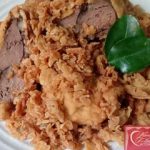Sotong Woku is a beloved traditional Indonesian seafood dish that showcases the rich flavors and culinary heritage of Indonesia’s coastal regions. Known for its vibrant spices and tender squid, Sotong Woku offers a delightful experience for seafood enthusiasts and cultural explorers alike. This dish is celebrated not only for its delicious taste but also for its cultural significance, often being served during special occasions and communal gatherings. As a staple in Indonesian cuisine, Sotong Woku exemplifies the harmonious blend of local ingredients and culinary techniques passed down through generations. Whether enjoyed as a main course or a festive delicacy, Sotong Woku continues to captivate taste buds and preserve Indonesia’s rich culinary traditions.
Origins and Cultural Significance of Sotong Woku in Indonesia
Sotong Woku originates from the coastal regions of Indonesia, particularly in North Sulawesi and surrounding areas where seafood is abundant. The dish reflects the maritime culture of the local communities, who have relied on the sea for sustenance for centuries. The term "Woku" refers to a cooking style that involves blending aromatic spices with fresh ingredients, often cooked in banana leaves or traditional pots. Historically, Sotong Woku has been a part of ceremonial feasts and communal celebrations, symbolizing unity and abundance. Its preparation and consumption are deeply rooted in local traditions, serving as a reminder of the islanders’ close relationship with the ocean. Over time, Sotong Woku has gained popularity beyond its native regions, becoming a representative dish of Indonesian seafood cuisine.
The cultural significance of Sotong Woku extends beyond its flavor; it embodies the spirit of togetherness and respect for nature’s bounty. In many communities, preparing and sharing this dish is an act of social bonding, reinforcing familial and communal ties. It also highlights the resourcefulness of local cooks who utilize readily available ingredients to create complex flavors. The dish’s popularity has led to its inclusion in various culinary festivals and cultural events, where it is celebrated as a symbol of regional identity. As Indonesian cuisine continues to evolve, Sotong Woku remains a cherished tradition that honors the nation’s maritime heritage and diverse culinary artistry.
In addition to its cultural roots, Sotong Woku also plays a role in promoting sustainable fishing practices. By utilizing squid, a sustainable seafood option, the dish encourages environmentally conscious choices among consumers. The dish’s cultural importance and sustainable aspects make it a meaningful representation of Indonesia’s connection to the sea. It serves as a culinary ambassador that preserves traditional knowledge while adapting to modern tastes. Overall, Sotong Woku is more than just a flavorful dish; it is a cultural artifact that reflects Indonesia’s rich history, community values, and relationship with its natural environment.
The dish has also inspired regional variations that incorporate local spices and cooking techniques, further enriching its cultural tapestry. These variations demonstrate the adaptability and regional pride associated with Sotong Woku, making it a versatile and enduring element of Indonesian culinary identity. Its significance continues to grow as chefs and home cooks alike embrace its flavors and cultural heritage. Sotong Woku remains a testament to Indonesia’s vibrant food culture, embodying tradition, community, and the bounty of the sea.
Key Ingredients Used in Preparing Authentic Sotong Woku
Preparing authentic Sotong Woku requires a harmonious blend of fresh ingredients and aromatic spices that define its distinctive flavor profile. The main component is fresh squid, which should be cleaned thoroughly and prepared to ensure tenderness. The squid’s natural sweetness pairs beautifully with the spicy and fragrant seasoning mixture. Key spices include turmeric, ginger, garlic, shallots, and red chili peppers, which create a vibrant and complex base. These ingredients are typically ground into a paste, forming the foundation for the dish’s rich flavor. Coconut milk is often incorporated to add creaminess and depth, balancing the heat and spices.
Additional ingredients that contribute to the authentic Sotong Woku include lemongrass, kaffir lime leaves, and bay leaves, which impart fresh citrus and herbal notes. Tamarind or lime juice is used to add a tangy brightness that enhances the dish’s overall flavor. Some recipes also include daun salam (Indonesian bay leaf) and galangal for extra aromatic qualities. Vegetables such as tomatoes, green beans, or bean sprouts may be added for texture and color, depending on regional preferences. The use of local herbs and spices highlights Indonesia’s diverse culinary palette, making each variation unique while maintaining the dish’s traditional essence.
Coconut oil or palm oil is typically used for sautéing the spice paste, which helps to develop a fragrant aroma and deepen the flavors. Salt, sugar, and sometimes shrimp paste (terasi) are added to taste, balancing the savory, sweet, and spicy elements. Freshness of ingredients is crucial for achieving an authentic Sotong Woku, as it enhances the dish’s natural flavors and ensures a vibrant, appetizing appearance. The combination of these ingredients results in a flavorful, aromatic sauce that coats the tender squid perfectly.
In essence, the key ingredients of Sotong Woku reflect Indonesia’s rich spice trade history and the regional abundance of fresh seafood. The careful selection and preparation of these components are vital for creating an authentic dish that captures the essence of traditional Indonesian cuisine. The harmonious interplay of spices, herbs, and seafood ingredients makes Sotong Woku a memorable culinary experience that celebrates Indonesia’s diverse flavors.
Step-by-Step Guide to Cooking Delicious Sotong Woku
To prepare authentic Sotong Woku, start by cleaning fresh squid thoroughly, removing the innards and beak, then slicing it into rings or suitable pieces. Set aside. Prepare the spice paste by blending garlic, shallots, red chili, turmeric, ginger, and other spices until smooth. In a wok or large skillet, heat coconut oil over medium heat and sauté the spice paste until fragrant and oil begins to separate, indicating it’s cooked. Add lemongrass, kaffir lime leaves, and bay leaves to infuse the aromatic base with herbal notes.
Next, pour in coconut milk and stir well to combine with the spice mixture. Bring the mixture to a gentle simmer, allowing the flavors to meld and the sauce to thicken slightly. Add the squid pieces to the wok, stirring gently to coat them evenly with the sauce. Cook for about 5-7 minutes, or until the squid turns opaque and tender. Adjust seasoning with salt, sugar, and lime juice to taste. The dish is ready once the squid is cooked through and the flavors have developed fully.
For added flavor and texture, some cooks include chopped tomatoes or green beans during the simmering process. The dish should be cooked just enough to keep the squid tender and prevent overcooking, which can make the seafood rubbery. Serve Sotong Woku hot, garnished with fresh herbs like cilantro or additional kaffir lime leaves if desired. The dish pairs well with steamed rice, which helps balance the spicy and creamy sauce.
Throughout the cooking process, maintaining a gentle heat ensures the squid remains tender and the flavors are well-developed. It’s important to taste and adjust seasonings at various stages to achieve the perfect balance of spice, acidity, and sweetness. Once finished, serve your Sotong Woku immediately for the best flavor and texture. With practice, this step-by-step method will help you create a delicious, authentic Indonesian seafood dish that captures the essence of traditional flavors.
Common Variations and Regional Differences in Sotong Woku Recipes
While the core concept of Sotong Woku remains consistent, regional variations across Indonesia introduce unique twists and flavor profiles that reflect local ingredients and culinary traditions. In North Sulawesi, for example, the dish often features a more prominent use of coconut milk and a slightly spicier, tangier flavor due to the addition of tamarind or lime juice. Some recipes incorporate local herbs like kemangi (lemon basil) for an aromatic touch, elevating the dish’s freshness.
In other regions, such as Manado, the dish may include a splash of vinegar or vinegar-based seasoning to add a subtle acidity that complements the sweetness of the squid. Variations from Central Indonesia might feature the use of turmeric and galangal more prominently, giving the dish a deeper, earthier flavor. Some recipes also incorporate local chili varieties, which can vary in heat and flavor intensity, resulting in milder or spicier versions of Sotong Woku.
Additionally, regional cooks might adapt the dish by adding vegetables like green beans, carrots, or bean sprouts to create a more hearty and textured version. The choice of herbs and spices is often tailored to local tastes, with some areas favoring a milder, more herbal approach, while others emphasize bold, spicy flavors. These regional differences showcase Indonesia’s culinary diversity and the flexibility of Sotong Woku as a dish adaptable to local ingredients.
In terms of presentation, some regions serve Sotong Woku wrapped in banana leaves or with additional garnishes like fried shallots or chopped scallions. Variations may also include different cooking techniques, such as grilling the squid beforehand for a smoky flavor or simmering it longer for a thicker sauce. Despite these differences, the dish maintains its fundamental identity as a flavorful, aromatic seafood stew.
These regional adaptations not only enrich the dish’s culinary landscape but also highlight Indonesia’s vibrant food culture. They allow for personalized touches that honor local ingredients and preferences, making Sotong Woku a versatile and dynamic part of Indonesian cuisine. Exploring these variations provides a deeper appreciation of the country’s diverse regional flavors and cooking traditions.
Nutritional Benefits of Including Sotong Woku in Your Diet
Sotong Woku is not only a flavorful dish but also offers several nutritional benefits that make it a healthy addition to a balanced diet. Squid, the primary ingredient, is a rich source of high-quality protein, essential for muscle building and tissue repair. It is low in fat, particularly saturated fat, making it a heart-healthy choice when prepared with minimal oil and healthy ingredients. Squid also contains important minerals such as zinc, selenium, and phosphorus, which support immune function, antioxidant activity, and bone health.
Furthermore, squid is an excellent source of omega-



